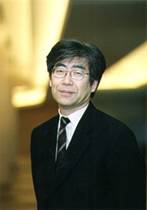

 |
 |
|
|
|
||||||||||||||||||||
Namjo Fumio |
|
 What sort of exhibition will Yokohama 2000 be? Nanjo: I hope it will be an exhibition that gives viewers special experiences, experiences that become part of them. The visual, physical, and intellectual experiences provided by art are different from those we get from ordinary entertainment, whether television, literature, or sports. I hope that the stimulus people obtain from the exhibition will stay with them and make them want to see more of the same. I hope the exhibition will help them become aware of other world views and versions of common sense that differ from their own and make them realize that there are a lot of things they don't know about and many different ways of looking at things, and that this will motivate them to look at more new art. This is the kind of exhibition I am looking forward to. What kind of artists are you choosing? Nanjo: We did not want to just repeat what had been done before, so we looked for artists who we felt could come up with the most appropriate proposals for a show located in Japan and specifically in Yokohama, considering the place and its history and culture in a broad sense. We want artists who are always pushing the envelope, who are capable of injecting a fresh viewpoint into their work. We are using collaboration as a keyword for this exhibition, but it means more than artists working together with other artists. We think it is important for an artist to have the breadth of vision to be able to work with people or make use of ideas and discoveries from other fields such as architecture, fashion, science and philosophy. I believe such interchanges make it possible to create a bridge between art and the real life of the viewers, making it more relevant to them. International exhibitions are being held throughout the world. What are your chief aims in organizing a triennial exhibition in Yokohama at the present time? Nanjo: There are two main tasks we need to accomplish. Since this is the first international exhibition of this kind to be held in Japan, one of our missions is to give the ordinary Japanese, who may not have seen much contemporary art, the knowledge that this world exists. And we hope they will find it interesting. The other is to convey something new to the overseas visitor, who has plenty of experience of contemporary art. We need to convince them that there is something different for them here, that we have our own viewpoint and that it is significant, and, as a result, get them to come again next time. The job of the artistic directors is to find a way to effectively achieve both of these aims, which might seem contradictory. Can you tell us something about the City of Yokohama? What are its attractions? Nanjo: In Japan, Yokohama has an image of being a port city that is open to the outside world, a city whose inhabitants tend to be sophisticated and internationally minded. Another important fact is that it has the second largest population in Japan. This means that many local people will be able to attend this event and it will also be accessible to the people of Tokyo. Yokohama is also known for its old Western-style buildings and its China town. What will be the effect of the Yokohama triennial on the world art scene and on art here in Japan? What will it do for Yokohama, the site of the exhibition? Nanjo: We want this show to make a contribution to global culture, not just provide a showcase for overseas art in Japan. I believe that the main contribution we can make to the development of world culture is to present contemporary art from a Japanese or Asian point of view. If Yokohama can represent Japan effectively in playing this role, it will have a achieved a great deal in advancing its civic culture. What message would you like to convey to the people who will see the exhibition? Nanjo: I want them to think of it as an opportunity to having some interesting experiences, not be intimidated because they think it will be difficult to understand. Art is a kind of mental gymnastics. In the year 2002, the World Cup soccer games will come to Yokohama. Participants in sports can feel the joy of making use of their physical abilities, using the body given to all human beings. In experiencing art, there is a different kind of joy that comes from making full use of the brain and the senses, discovering the power of expression, gaining more understanding, and sensing beauty. It is part of the joy of living to feel that one's capacity for these things has expanded a little more today than yesterday, that one can understand more than before. I hope that the experience of art will be taken more positively, and that many more Japanese will learn to make it a part of their everyday life. |
|